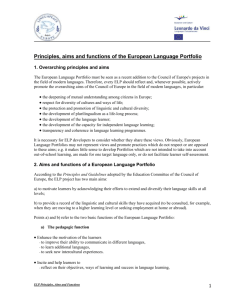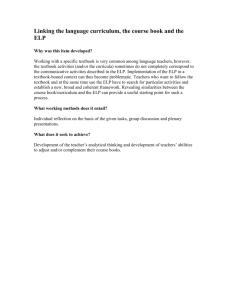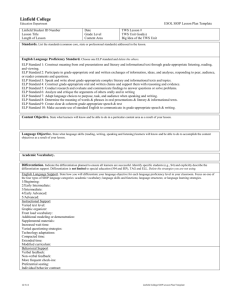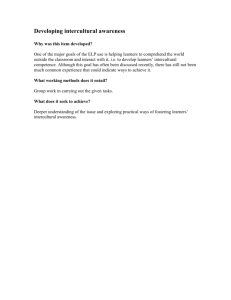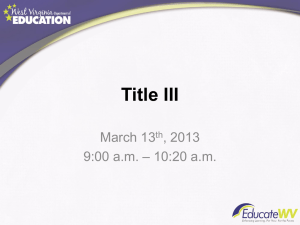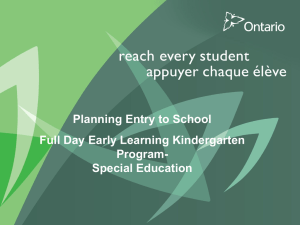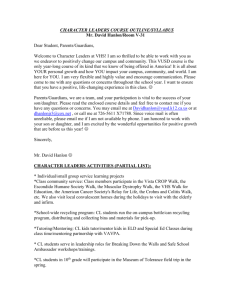Languages in and for Education
advertisement
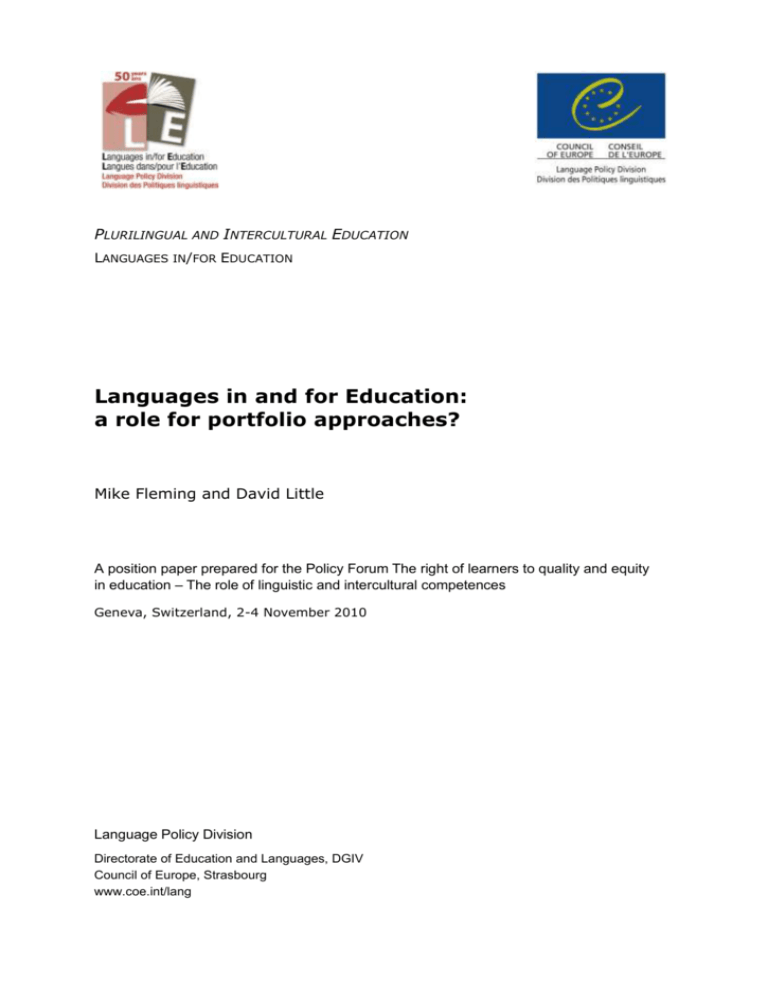
PLURILINGUAL AND INTERCULTURAL EDUCATION LANGUAGES IN/FOR EDUCATION Languages in and for Education: a role for portfolio approaches? Mike Fleming and David Little A position paper prepared for the Policy Forum The right of learners to quality and equity in education – The role of linguistic and intercultural competences Geneva, Switzerland, 2-4 November 2010 Language Policy Division Directorate of Education and Languages, DGIV Council of Europe, Strasbourg www.coe.int/lang © Council of Europe, September 2010 The opinions expressed in this work are those of the authors and do not necessarily reflect the official policy of the Council of Europe. All correspondence concerning this publication or the reproduction or translation of all or part of the document should be addressed to the Director of Education and Languages of the Council of Europe (Language Policy Division) (F-67075 Strasbourg Cedex or decslang@coe.int). The reproduction of extracts is authorised, except for commercial purposes, on condition that the source is quoted. Table of contents Introduction ............................................................................................................................. 5 1 Council of Europe values and their impact on education ........................... 5 2 The Language Policy Division and portfolios .................................................. 7 2.1 The European Language Portfolio (ELP) .......................................................... 8 2.2 Autobiography of Intercultural Encounters (AIE) ........................................ 10 2.3 The future of the ELP ........................................................................................... 10 3 The LE Project.............................................................................................................. 11 4 Portfolio approaches within the LE project..................................................... 12 4.1 Primary ....................................................................................................... 13 4.2 Post-primary/secondary ........................................................................... 13 Conclusion ............................................................................................................................. 13 Introduction The European Language Portfolio (ELP) was introduced as a concept in 1997 and formally launched in 2001. It has been taken up in almost thirty Council of Europe member states and 107 models had been accredited by the spring of 2010. The ELP is concerned with the learning and use of second and foreign languages (L2s), which is just one focus of the Languages in Education/Languages for Education (LE) project. Founded on key Council of Europe values, the LE project aims to promote plurilingual and intercultural education for all and is particularly concerned to support the inclusion of learners from vulnerable, disadvantaged and marginalised social groups. The principles it has elaborated, the arguments it has developed, and the tools it offers to member states have implications for the organisation and content of curricula. But it is not enough that education should be informed, perhaps even shaped, by Council of Europe values; it should also seek ways of imparting those values to learners as a central part of their educational experience. This implies a need for instruments that support pedagogical approaches based on those values. This paper therefore poses the following questions: Can portfolio approaches supply such instruments? If they can, how should they be configured? Does the much wider scope of the LE project have implications for the scope and structure of the ELP? Can the LE project benefit from the pedagogical experience that has accumulated over ten years of ELP implementation? 1 Council of Europe values and their impact on education The Council of Europe’s mission is to protect human rights, democracy, and the rule of law, which it acknowledges as essential foundations of a tolerant and civilised society and indispensable for European stability, economic growth and social cohesion. These values explain the organisation’s commitment to social inclusion, social cohesion, respect for diversity, and intercultural dialogue. They also explain its central concern with education for democratic citizenship and the role that languages play in this process. Effective participation in democratic practice depends on a capacity for using language reflectively, analytically and critically; and when democratic practice extends beyond linguistic borders, it also depends on a capacity to communicate in more than one language. Both considerations have always been central to the Council of Europe’s work in education. In the 1970s the organisation was closely associated with a movement shaped by the concept of permanent education (“lifelong learning” in its more recent formulation). Innovative proposals of many different kinds belonged to this movement by virtue of the attention they paid to “the need to develop the individual’s freedom by developing those abilities which will enable him to act more responsibly in running the affairs of the society in which he lives”.1 This inescapably political agenda derives from the view that adult education should be 1 H. Holec, Autonomy and foreign language learning, Oxford: Pergamon, 1981, p.1. (First published 1979, Strasbourg: Council of Europe.) Language Policy Division 5 Council of Europe an instrument for arousing an increasing sense of awareness and liberation in man, and, in some cases, an instrument for changing the environment itself. From the idea of man “product of his society”, one moves to the idea of man “producer of his society”.2 According to this view adult education should aim to improve the quality of life by promoting equality of opportunity, responsible autonomy, personal fulfilment, and democratisation of the educational process.3 In this context democratisation was held to mean two things: giving adults the opportunity to “offset inequalities of access to the various levels and types of schools now existing” and “fostering a new type of cultural production by taking the real problems of everyday life into account”.4 These ideas inspired a new approach to foreign language education that found its first expression in Henri Holec’s Autonomy and foreign language learning, published by the Council of Europe in 1979. Holec’s argument for a move from “directed teaching” to “self-directed learning” was motivated by a combination of political and practical principles, captured in the declaration that one of the Council of Europe’s ideals was to make the process of language learning more democratic by providing the conceptual tools for the planning, construction and conduct of courses closely geared to the needs, motivations and characteristics of the learner and enabling him so far as possible to steer and control his own progress.5 For Holec the concept of autonomy had consequences for the way in which learning is organised – he defined the autonomous learner as one who has “the ability to take charge of [his or her] learning”6 – but it also had consequences for the kind of knowledge that is acquired. If learners themselves determine the goals and content of learning, “objective, universal knowledge is [...] replaced by subjective, individual knowledge”: “the learner is no longer faced with an ‘independent’ reality […], to which he cannot but give way, but with a reality which he himself constructs and dominates.”7 Holec’s organisational concerns were prompted by the need to respond to the challenges and potential of new technologies, and they stimulated a rapid growth of interest in self-access and self-instructional language learning. His epistemological insights, on the other hand, coincided with pedagogical developments informed by constructivist theories of learning in which language and communication play a central role. Based on various forms of classroom research, these theories argued that knowledge is constructed via collaborative processes that are driven by exploratory, interactive talk; that “what [pupils] learn can hardly be distinguished from the ability to communicate it”;8 and that speech, “while not identical with thought, provides a means 2 H. Janne, Organisation, content and methods of adult education, Strasbourg: Council of Europe, 1977, p.15. 3 Ibid., pp.16–17. 4 Ibid., p.17. 5 J. L. M. Trim, Some possible lines of development of an overall structure for a European unit/credit scheme for foreign language learning by adults, Strasbourg: Council of Europe, 1978, p.1. 6 Loc. cit., p.3. 7 Ibid., p.21. 8 D. Barnes, From communication to curriculum, Harmondsworth: Penguin, 1976, p.20. Language Policy Division 6 Council of Europe of reflecting upon thought processes, and controlling them”.9 According to this view language is at once the medium in which we express knowledge and the tool that allows us to explore and reflect on the modes of its construction: “Language allows one to consider not only what one knows but how one knows it, to consider, that is, the strategies by which one is manipulating the knowledge, and therefore to match the strategies more closely to the problem”.10 These arguments are the origin of more recent work on “dialogic pedagogy”, which is increasingly central to pedagogical research in several European countries and is closely associated with portfolio learning and assessment.11 Such work provides empirical underpinning for the view that as an epistemological phenomenon, learner autonomy is constructed and enacted in classroom discourse that is authentically dialogic. The reciprocal nature of dialogue helps to ensure that curriculum knowledge is brought into critical interaction with the knowledge and experience that learners bring with them to school. It also provides a dynamic that allows learners gradually to internalise the language of schooling as they appropriate the knowledge that school offers. The more recent association of the concept of the “autonomous learner” with the social aspects of learning and genuinely dialogic talk helps to avoid the misinterpretation of “autonomy” in this context as focusing on individuality at the expense of the communal and social. On the contrary, knowledge and understanding develop not in a private world but in shared, communal contexts; language acquires meaning in contexts of active use. This avoids a false dichotomy between a purely subjective, relativist account (that the individual alone constructs knowledge) and an objective view (that the individual is simply a recipient of an external reality). The implication then of translating Council of Europe values into educational practice is to see the learner not simply as a passive, isolated receiver of knowledge but as an active, reflective, communal participant, aware of his or her own plurilingual repertoire, valuing diversity and developing critical thinking skills. These are the goals that portfolio approaches seek to support. 2 The Language Policy Division and portfolios The Language Policy Division currently promotes two portfolios, the European Language Portfolio (ELP)12 and the Autobiography of Intercultural Encounters (AIE).13 Both should be seen in the broader context of portfolio learning and portfolio assessment, concepts that were first developed as a reaction to assessment by standardised tests. The early proponents of portfolios argued that standardised tests do little to support learning; on the contrary, they encourage the belief that there is no necessary link between teaching and learning on the one hand and assessment on the 9 Ibid., p.98. Ibid. 11 For example: R. J. Alexander, Towards dialogic teaching: rethinking classroom talk, York: Dialogos, 2006; N. Mercer, The guided construction of knowledge: talk amongst teachers and learners, Clevedon: Multilingual Matters, 1995; N. Mercer & K. Littleton, Dialogue and the development of children's thinking: a sociocultural approach, Abingdon: Routledge, 2007; U. Ruf, S. Keller & F. Winter, Besser Lernen im Dialog. Dialogisches Lernen in der Unterrichtspraxis, Seelze-Velber: Klett/ Kallmeyer, 2008; F. Winter, Leistungsbewertung. Eine neue Lernkultur braucht einen anderen Umgang mit den Schulleistungen, Baltmannsweiler: Schneider, 2004. 12 www.coe.int/portfolio 13 www.coe.int/lang Autobiography of Intercultural Encounters 10 Language Policy Division 7 Council of Europe other. Portfolios, by contrast, are a means of bringing learning and assessment into positive interaction: assessment of learning can also be assessment for learning. The philosophy that they embody is thus a close relative of the assessment-for-learning movement in the United Kingdom14 and the growing interest in dialogic pedagogy referred to above. Portfolios can help to structure the learning process – for example, learners may use a portfolio to accumulate and shape the materials they gather for a particular project; portfolios can also provide a basis for assessment that focuses on learning not only as product but as process; and they can be used to display learning achievement. In their different ways the ELP and the AIE both reflect this range of potential. 2.1 The European Language Portfolio (ELP) Although its final shape was determined by the Council of Europe’s project Language Learning for European Citizenship (1989–96), the ELP bears the unmistakable mark of earlier Council of Europe projects. Its reporting function arises from the same concerns that animated attempts in the 1970s to develop a European unit/credit system for L2 learning by adults;15 while its pedagogical function reflects the Council of Europe’s commitment to cultural exchange, lifelong learning and learner autonomy. The decisive impetus to develop the ELP came from the Rüschlikon Symposium of 1991 (“Transparency and coherence in language learning in Europe”), hosted by the Federal Swiss authorities in collaboration with the Swiss Conference of Cantonal Directors of Education. In its conclusions the symposium recommended that the Council of Europe should promote the development of a Common European Framework of reference for language learning and set up a working party to consider possible forms and functions of a European Language Portfolio. The purpose of the Common European Framework would be to “promote and facilitate cooperation among educational institutions in different countries; provide a sound basis for the mutual recognition of language qualifications; [and] assist learners, teachers, course designers, examining bodies and educational administrators to situate and coordinate their efforts”.16 The ELP “should contain a section in which formal qualifications are related to a common European scale, another in which the learner him/herself keeps a personal record of language learning experiences and possibly a third which contains examples of work done. Where appropriate entries should be situated within the Common Framework”.17 This recommendation clearly anticipates the ELP’s tripartite structure (language passport, language biography, dossier), the interdependence of its pedagogical and reporting functions, and its relation to the Common European Framework of Reference for Languages (CEFR). According to the Principles and Guidelines that explain what it is, the ELP reflects the Council of Europe’s “respect for diversity of cultures and ways For example, P. Black & D. Wiliam, “Assessment and classroom learning”, Assessment in Education 5.1, 1998, pp.7–74; P. Black & D. Wiliam, “Assessment for learning in the classroom”, in J. Gardner (ed.), Assessment and learning, London: Sage, 2006, pp.9–25. 15 See, for example, Council for Cultural Cooperation, A European unit/credit system for modern language learning by adults: report of a symposium held at Ludwigshafen-am-Rhein, Germany, 7–14 September 1977, Strasbourg: Council of Europe, 1979. 16 Council for Cultural Cooperation, Transparency and coherence in language learning in Europe: objectives, evaluation, certification, Report on the Rüschlikon Symposium, Strasbourg: Council of Europe, 1992, p.37. 17 Ibid., p.40. 14 Language Policy Division 8 Council of Europe of life”, “the development of plurilingualism as a lifelong process”, and “the development of the capacity for independent language learning”.18 Thus accredited ELPs should raise awareness of the intercultural dimension of L2 learning and use, promote plurilingualism, and foster the development of learner autonomy. These goals are achieved by adopting approaches to teaching and learning that assign a central role to two kinds of reflective practice. The first is a matter of thinking about learning how to learn and the intercultural and plurilingual implications of L2 learning and use. Most ELPs attempt to trigger such thinking by providing pages that guide the analysis of learning styles and strategies, allow users to record significant intercultural encounters, and invite them to construct a profile of their plurilingual repertoire. Reflection can be an interactive and communicative as well as an individual and cognitive process; and although maintaining an ELP is something that must be done by the individual learner, his or her capacity to reflect analytically and critically is most likely to be developed in exploratory talk with the teacher and other learners that is based on such pages. The second kind of reflective practice required by the ELP focuses on the learner’s developing communicative proficiency. Checklists of “I can” descriptors arranged according to the activities (LISTENING, READING, SPOKEN INTERACTION, SPOKEN PRODUCTION, WRITING) and proficiency levels of the CEFR are used to identify learning targets, monitor learning progress and assess learning outcomes. Self-assessment is a skill that learners must develop; and again this is most likely to happen via exploratory talk with the teacher and other learners – for example, discussion of what exactly a particular communicative task entails, or what kinds of evidence learners need to be able to present in support of their self-assessment claims. Peer-assessment may be used to give the practice of self-assessment a collaborative, interactive dimension.19 The ELP’s three main concerns – learner autonomy, intercultural learning, plurilingualism – produce a multidimensional tool that reflects key concerns of the Council of Europe. In practice, however, implementation projects have tended to focus more on learner autonomy than on the other two concerns. This is not surprising: in most contexts the ELP must be accommodated alongside the textbook and other teaching/learning materials, so the scope for using it is not unlimited. Also, since the pilot projects (1998–2000) the ELP has mostly been used by individual teachers of particular languages rather than by teams of language teachers working together in a school or other educational institution.20 It seems reasonable to assume that plurilingualism and intercultural learning will come into their own only when the ELP is used to bring the learning of different languages and contact with different cultures into interaction with one another, and for that it may be necessary to create a new kind of curriculum space. 18 See European Language Portfolio: key reference documents, Strasbourg: Council of Europe, 2006, p.8 (www.coe.int/portfolio PROCEDURE FOR VALIDATION). 19 For a preliminary discussion of the implications of the ELP for assessment in general, see D. Little, “The European Language Portfolio: where pedagogy and assessment meet”, Strasbourg: Council of Europe, 2009 (www.coe.int/portfolio). 20 Note, however, that the ECML’s current medium-term programme includes a project that is exploring whole-school use of the ELP (elp-wsu.ecml.at). Language Policy Division 9 Council of Europe 2.2 Autobiography of Intercultural Encounters (AIE) The Autobiography of Intercultural Encounters grew out of the ELP. As noted above, early adopters of the ELP tended to focus especially, and sometimes exclusively, on its potential to support the development of learner autonomy. This prompted the formulation of proposals designed to counteract a perceived tendency to downplay the ELP’s intercultural focus. But the proposals quickly took on a life of their own and were developed separately as a follow-up to the Council of Europe’s White Paper on Intercultural Dialogue “Living together as equals in dignity”.21 Section 5.3 of the White Paper states: “Complementary tools should be developed to encourage students to exercise independent critical faculties including to reflect critically on their own responses and attitudes to experiences of other cultures”. The AIE is designed to bring such critical reflection to bear on a single intercultural encounter. It comprises a sequence of questions whose order is determined by research into the development of intercultural awareness. In the standard version, for adolescents and adults, the questions are divided into the following sections: THE ENCOUNTER, THE OTHER PERSON OR PEOPLE, YOUR FEELINGS, THE OTHER PERSON’S FEELINGS, SAME AND DIFFERENT, TALKING TO EACH OTHER, FINDING OUT MORE, USING COMPARISONS TO UNDERSTAND, THINKING BACK AND LOOKING FORWARD. The version for younger learners provides a somewhat simpler framework that has the same general structure.22 The AIE is designed to prompt the same kind of reflection as the ELP pages that are concerned with learning how to learn, intercultural learning and plurilingualism. Although the standard version can be used exclusively for individual reflection, it can also be mediated and its reflective processes can be supported by exploratory talk; while the version for younger learners is explicitly designed to be mediated by such talk since younger learners may not be able to read the questions for themselves, let alone compose written responses. Thus like the ELP, the AIE offers to support the development of the learner’s capacity for reflection by providing a stimulus and focus for reflective discussion. Again the link with dialogic pedagogy is unmistakable. 2.3 The future of the ELP There is no doubt that the ELP has had a significant impact on L2 education across Europe, helping to bring learner autonomy, self-assessment, intercultural learning and the goal of plurilingualism to the attention of educational authorities, curriculum developers, textbook authors, teacher educators, teachers and learners. Yet despite the large number of ELPs that have been validated and accredited, implementation is often problematic. In some cases there is a lack of official support, but implementation is also hindered by the fact that the ELP’s concern with intercultural learning and plurilingualism challenges existing curricula, while its aim to promote learner autonomy challenges traditional classroom practices. Another barrier to widespread adoption seems to be the ELP’s size and scope. Especially when it must be accommodated alongside a textbook, its regular use in the classroom requires major adjustment to 21 www.coe.int/dialogue Both versions of the AIE and a range of support material can be downloaded from the Council of Europe’s website (www.coe.int/lang AUTOBIOGRAPHY OF INTERCULTURAL ENCOUNTERS). 22 Language Policy Division 10 Council of Europe existing pedagogical practice. It would thus almost certainly be counter-productive to extend the scope of ELPs designed for adolescent and adult learners.23 From 2011 the validation and accreditation of ELPs will be replaced by a process of registration based on self-declaration. The structure of the ELP will remain unchanged – language passport, language biography, dossier – as will its concern to foster learner autonomy, intercultural learning and plurilingualism. To facilitate the development of new models, the ELP Validation Committee has developed a suite of templates and other supports, and these seek to emphasise intercultural learning and plurilingualism as much as learner autonomy. In particular, the language passport templates for adolescents/adults and younger learners have been revised to accommodate the user’s developing plurilingual profile more fully than before.24 3 The LE Project As indicated in the introduction to this paper, the LE project also aims to promote plurilingual and intercultural education and has Council of Europe values at its core, especially the promotion of human rights and democracy. The project’s scope is wider than the acquisition of second languages, embracing as it does all aspects of language education including the languages of schooling (language as subject and language in other subjects), regional and minority languages, and modern foreign and classical languages. One key tenet of the LE project is that the multilingualism of societies and the plurilingualism of individual speakers is not something rarified and unusual but commonplace.25 Schools therefore have both a moral duty to forge policies and a pragmatic interest in creating instruments that are based on recognition of this diversity. The two aspects of language(s) of schooling, ‘language as subject’ (LS) and ‘language in other subjects’ (LIS), need to be seen in relation to each other. Language as subject is the designation used to refer to the teaching of a national/official language (and associated literature), e.g. the teaching of French in France or Greek in Greece. However, language education does not stop with language as subject. Language proficiency is equally needed in all other subjects, which are sometimes falsely considered as “non-linguistic”. Communication requirements such as reading and understanding expository texts, listening to explanations, giving an oral presentation or producing written texts are not only present in other subjects; they are closely determined by those subjects’ conceptual foundations and characteristic procedures. It is often wrongly assumed that the requisite competences and skills will somehow develop by themselves, without the need for particular attention in the subject classroom, or without specific (re-)training based on what has already been developed within language as subject. Recognition of these needs, however, is particularly important with regard to vulnerable learners. For more on the impact of the ELP, see M. Stoicheva, G. Hughes & H. Speitz, “The European Language Portfolio: an impact study”, Strasbourg: Council of Europe, 2009; available at www.coe.int/portfolio. 24 These templates and supports are available on the Council of Europe’s ELP website, www.coe.int/portfolio. 25 See Daniel Coste et al Plurilingual and intercultural education as a right. http://www.coe.int/t/dg4/linguistic/langeduc/ 23 Language Policy Division 11 Council of Europe With regard to the language of schooling, there are two main sources of disadvantage that need to be considered.26 Access to schooling is not equitable if the learners’ home language is not taught in schools as a subject and as a language of instruction for teaching other subjects. In addition, learners may struggle with different subjects if their competence in using the academic language of the school is limited. Their own language repertoire may be adequate in the social contexts in which they operate but may not allow them to have full access to the curriculum. For some pupils these two types of disadvantage may be combined, each reinforcing the other and compounding the disadvantage. All too often in schools the level of language competence that helps some pupils to success and causes others to fail is actually acquired not within the school itself but in the social contexts outside the school. Learners who start from a point of disadvantage may become even more disadvantaged if they are denied access to the curriculum for language reasons. The Platform of Resources and References for Plurilingual and Intercultural Education is an instrument of the Language Policy Division which is designed to enable member states to prepare their syllabi concerning languages of schooling and all other language instruction, according to aims such as their contribution to social cohesion and the development of democratic intercultural citizenship. The Platform contains theoretical papers but also practical resources. This prompts the question posed in the introduction: Does the wider scope of the LE project have implications for the scope and structure of the ELP? Is there potential for developing a portfolio that would support the wider frame of reference embraced by the LE project, including LS and LIS? The reflective teaching and learning that the ELP supports are also goals of the LE project. However, it seems appropriate to extend the scope and reach of the Council of Europe’s portfolio approaches not by adjusting or enlarging the structure of the ELP but by developing related tools to support other dimensions of language learning and use within a plurilingual and intercultural framework. This is especially the case for postprimary/secondary education. 4 Portfolio approaches within the LE project As we noted in our introduction, plurilingual and intercultural education based on Council of Europe values should seek ways of imparting those values to learners as a central part of their educational experience. Our discussion of the ELP and the AIE has shown that portfolio approaches to learning can be used to stimulate collaboration and help learners to engage with diversity of thinking and beliefs – they can help to develop openness to otherness and flexibility of thought while cumulatively providing feedback on mastery of content and skills development. As discussed above, the fact that language is central to the learning of all curriculum subjects is at the heart of the LE project which embraces language in other subjects as well as language as subject. The development of tools to support such approaches within the LE project is potentially a complex process because it needs to take account of the project’s diverse focuses, but without losing sight of the centrality of the individual learner’s developing plurilingual repertoire. Providing a profile of developing competence even in just LS presents a challenge, with its various components of speaking and listening, reading and writing 26 See Jean-Claude Beacco The Platform of Resources and References for Plurilingual and Intercultural Education in relation to ‘vulnerable’ groups. http://www.coe.int/t/dg4/linguistic/ Language Policy Division 12 Council of Europe and different genres within each category. Another complexity derives from the way the curriculum is organised in different phases. Differences between primary and postprimary/secondary education probably necessitate the development of different tools for each sector. 4.1 Primary In most school systems the primary curriculum is holistic and the majority of teachers are generalists. It may thus be possible to develop one or more primary portfolios that include but go beyond the ELP to provide teachers and learners with a single tool. We noted above that target-setting and self-assessment in the ELP are based on checklists of “I can” descriptors that are scaled according to the proficiency levels of the CEFR. There is no equivalent for the language of schooling (language as subject/language in other subjects), though at primary level it is worth considering to what extent ELP descriptors for reading and writing also apply to pupils’ L1 literacy development. Work on portfolios for this domain could draw on various existing resources, including: ELPs for primary learners, which already take account of intercultural learning and plurilingualism; tools that have been developed in some member states to support the development of an inclusive ethos in primary schools;27 and various projects of the ECML, especially Across languages and cultures (2004–2007) and A framework of reference for pluralistic approaches (2008–2011).28 4.2 Post-primary/secondary In most countries a major difference between primary and post-primary/secondary curricula is that the latter are taught by subject specialists who often have very little contact with teachers of other subjects. What is more, whereas the centrality of early literacy development to primary schooling means that language is at the centre of the teacher’s concerns, language is traditionally not seen as an issue in the teaching of non-language post-primary subjects. In principle it would be possible to develop portfolio approaches for language as subject and for non-language subjects. The former might be designed to stimulate reflection on the linguistic competences required for different domains of language use, perhaps including different curriculum subjects; the latter would seek to engage directly with the terminology, modes of argumentation and text types characteristic of the subject in question. An alternative approach would be to seek to integrate language as subject and language in other subjects by placing the emphasis in a portfolio on elements such as genres or types of language use. This approach would present more practical challenges. In either case the AIE might provide a useful model. The revised version of the ELP’s standard adult passport could be used to help learners keep track of their developing plurilingual repertoires. Conclusion It is our view that portfolio approaches have the potential to promote positive educational practice by offering concrete tools that can provide a record of achievement and promote reflection, learner autonomy and purposeful dialogue. The examples of the ELP and AIE show that “portfolio approach” can be defined fairly For example, in Ireland a cross-border project produced Together towards inclusion – toolkit for diversity in the primary school, available at www.ncca.ie/iilt. 28 Further details are available on the ECML website, www.ecml.at. 27 Language Policy Division 13 Council of Europe widely and does not have to be restricted to one particular model. Some approaches to portfolio use grids with competence statements as a focus for self-assessment linked to competence statements. Other approaches are more open-ended, prompting more general reflection on experiences, achievements and progress. A portfolio, depending on how it is conceived and structured, could provide an opportunity to monitor whether the learner’s right to language education is being fulfilled, a particularly significant dimension for vulnerable learners. There is potential for imaginative thinking on how learners and teachers can be supported in practical ways in order to achieve the high levels of competence in language that are required for an enriched life and for active participation in democratic processes. In the context of the LE project key questions need to be considered. For example, how can a portfolio approach: encourage appropriate meta-awareness and reflection on language to support learning? provide a rich record of achievement in the development of competence in all aspects of language? help raise subject teachers’ awareness of how language is integral to learning the subject? raise learners’ critical awareness of their developing plurilingual profile and intercultural capacity? include a social/communal element that prompts learners to see themselves in relation to others in their developing language profile? The Platform produced as part of the LE project provides a valuable range of resources to support policy makers and teachers in their understanding of theoretical dimensions and practical issues related to the development of language competence. Portfolio approaches have the potential to take the project to a further stage by providing more concrete and focused support for teachers and learners. Language Policy Division 14 Council of Europe
